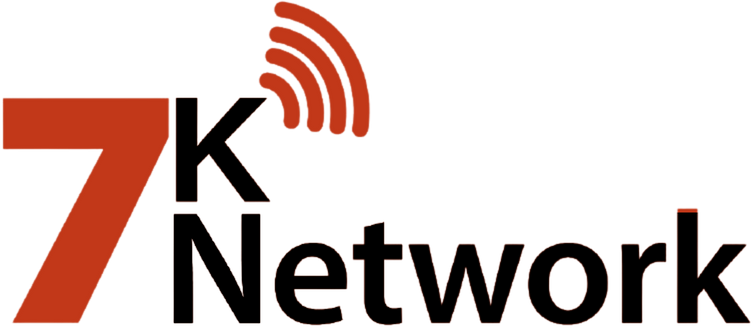The need to find a proper Lightroom alternative has become highly significant to photographers who need more choices than those provided by Adobe. Adobe Lightroom is still in use by many people, yet they are considering other programs with specialty features, lower prices, or alternative modes of working. The options available to professional photographers, hobbyists, or content creators are suitable for their needs in terms of editing and costs, as well as creativity.
This has aided the guide in reviewing fifteen robust photo editors that have the potential to vie with Lightroom and allow you to locate software that meets your vision and technical considerations.
Lightroom’s Role in Modern Photography
- Industry Standard: Adobe Lightroom established the guidelines of professional photo editing in all places.
- Cloud Integration: It is synced everywhere so that you can edit anywhere.
- RAW Processing Its intelligent algorithms maintain the quality when you use any camera.
- Organizational Tools: With good catalog systems you are able to work with thousands of photos in a jiffy.
- Preset Ecosystem: There are a lot of community presets that accelerate the work and provide it with a homogeneous appearance.
Limitations Driving Users to Alternatives
- Subscription Costs: Monthly charges will quickly accumulate, rendering it costly in the long run.
- Performance Problems: Bigger Cat Nice the software down.
- Learning Curve: The interface is difficult to use by those who would prefer something simpler.
- Lack of Creativity: The tools created by Adobe may be limited to experimental art.
- Vendor Lock-In: It has a private format of catalogs so that it is difficult to change to a different program.
What Makes a Good Lightroom Alternative?
- RAW Support: It supports most camera formats on a professional basis.
- Non-Destructive Editing: You are able to modify pictures without having to modify the original.
- Easy to Use Interface: The interface is easy to use, which reduces learning time and increases efficiency.
- Optimization of performance: Speeds and responsiveness are useful when working with big projects.
- Value Proposition: It also has good pricing or free variations, allowing the user to use alternatives without sacrificing quality.
Also Read: Photographer Bio for Instagram
Comparison Table: Top Lightroom Alternatives
|
Name |
Price Model |
Best For |
|
Capture One Pro |
$299 one-time or $20/month |
Professional studio photographers needing color precision |
|
DxO PhotoLab |
$219 one-time |
Noise reduction and optical corrections specialists |
|
Skylum Luminar Neo |
$79/year |
AI-powered creative enhancements and quick edits |
|
Darktable |
Free | Mobile photographers editing on the go |
|
ON1 Photo RAW |
$99.99/year |
All-in-one editing without subscriptions |
|
Affinity Photo |
$69.99 one-time |
Designers combining photo and graphics work |
|
Photopea |
Free (browser) |
Quick online edits without installations |
|
Snapseed |
Free |
Mobile photographers editing on-the-go |
|
RawTherapee |
Free |
Technical users wanting granular control |
|
CyberLink PhotoDirector |
$54.99/year | AI tools and creative effects enthusiasts |
|
VSCO |
Free + premium |
Mobile content creators seeking aesthetic filters |
|
digiKam |
Free |
Linux users managing extensive photo libraries |
|
Zoner Photo Studio X |
$59/year |
Complete workflow from import to sharing |
|
Pixlr |
Free + premium |
Casual users needing basic online editing |
|
LightZone |
Free |
Zone System photography practitioners |
We suggest that you check this blog and YouTube Alternatives
15 Best Lightroom Alternatives (Top Picks for 2026)
A) Professional / High-End
1. DxO PhotoLab
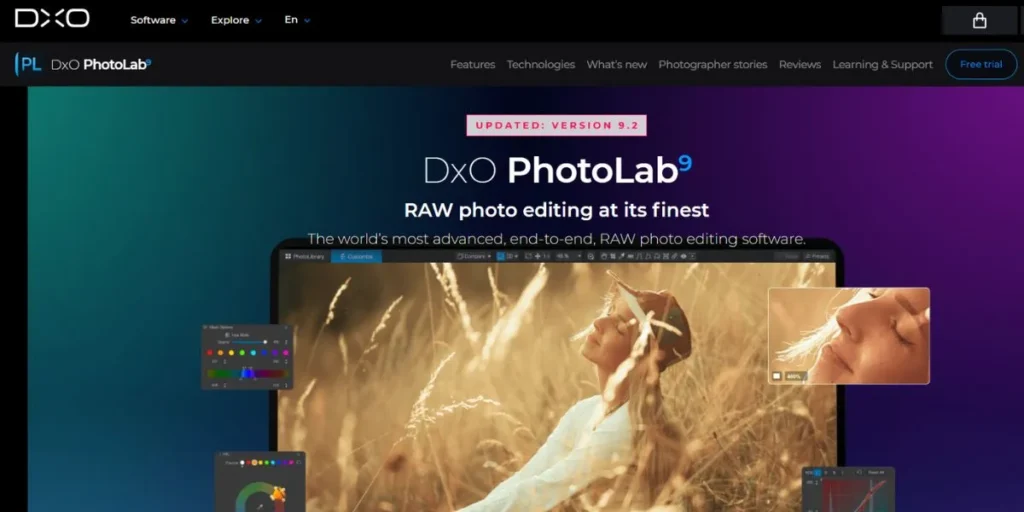
DxO PhotoLab is already one of popular Lightroom alternatives that is reputed to have good optical adjustments and noise reduction. It assists you in extracting information in deserted lighting and yet making pictures to appear natural. The camera and lens profiles, which are built in, correct distortions, vignette, as well as color, such that they correspond to the gear. The PRIME noise-reduction technology of DxO is a leader on the market. The software targets photographers who take pride in quality, and they will not be satisfied with the lesser.
Key Features:
- DxO Pure RAW is compatible with files to enhance the removal of noise.
- Auto lens correction of various camera lens combinations.
- The ability to make edits with local controls.
- ClearView Plus eliminates haze and natural contrast is preserved.
- Smart Lighting is exposure balanced without unnatural appearance.
Pros:
- Do not produce very many artifacts in most tests
- Best image quality
- Do not produce very many artifacts in most tests
- Batches save time by correcting automatically.
- Keeps edits non‑destructive
Cons:
- More difficult to learn than easy editors.
- Costly compared to low-end products.
- Not as many creative effects as AI-based competitors.
Website: https://www.dxo.com/dxo-photolab
2. Capture One Pro
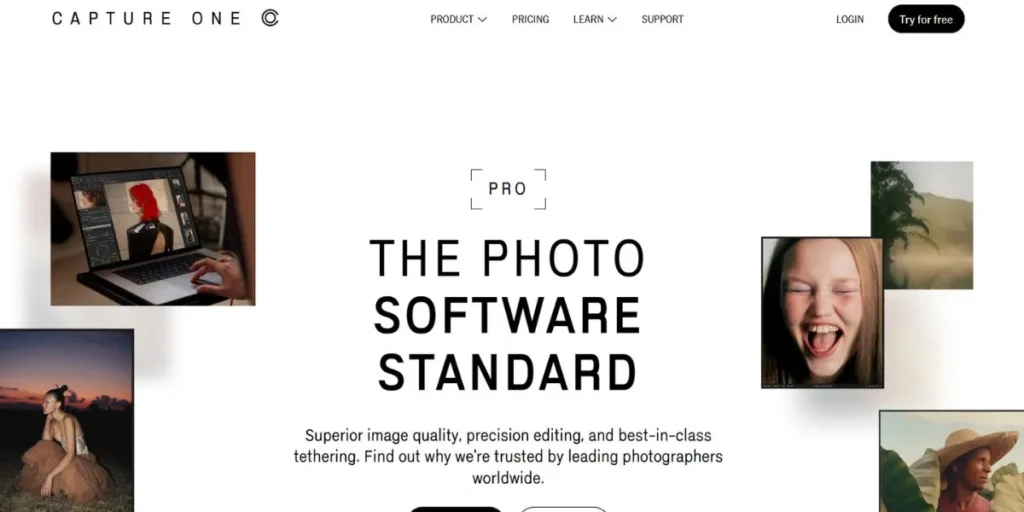
Capture One Pro is regarded as the best alternative to Lightroom when the best color quality and studio shooting features are required among professionals. It is also effective in commercial, fashion, and studio settings where color plays an important role. The interface may be personalized to every worker and provides layer-based editing to provide local changes with precision. Deep color grading has been supplied by Capture One, which is not comparable with other programs. Phase One continues to update to cover new cameras.
Key Features:
- Tethering of studio shoots in Lead time.
- Selecting the color with a fine hue, saturation, and light.
- Designed personal working environments.
- Non-destructive local editing Layer changes.
- Quick look presets of consistency.
Pros:
- Unsurpassed test color, applied to commercial work.
- Can deal with big libraries easily.
- Raw processing preserves all image detail.
Cons:
- Price high for hobbyists
- Needs a powerful computer
- Interfaces may impress those who use less complex software.
Website: https://www.captureone.com/en/products/capture-one-pro
3. Affinity Photo
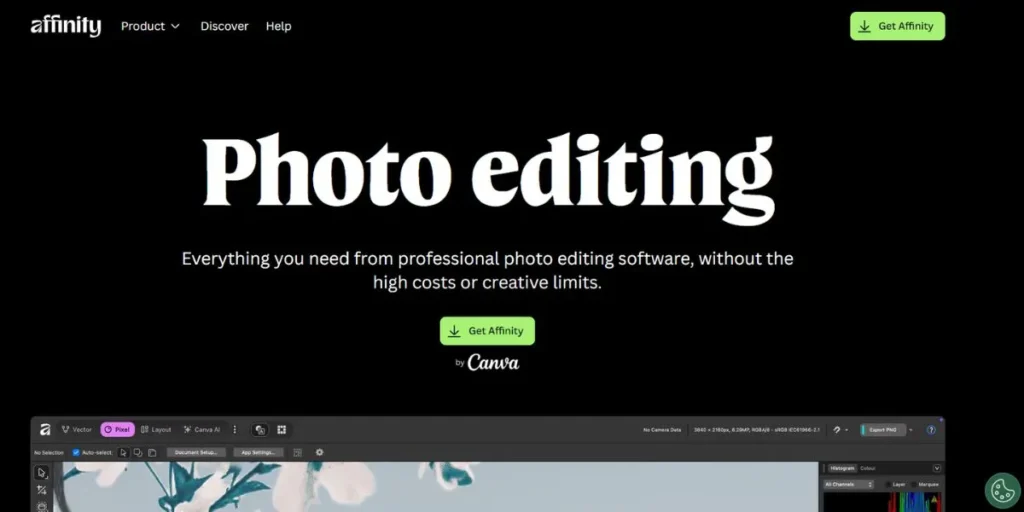
Affinity Photo is one of best Lightroom alternatives, which is professionally powerful and yet cheap with a single time purchase. It combines photo editing, composing, and designing in a single location. It does not require a subscription, thus suitable for those with high budgets. The software works with RAWs effectively and provides such complex settings as frequency separation, focus stacking and panoramas. It has desktop/iPad capability, and allows editing anywhere.
Key Features:
- Major camera Full RAW engine.
- Infinite mix and stacking of mixes
- Unlimited layers and blending of intricate mixes.
- Frequency separation based portrait retouching.
- Trend following: deep detail stacking.
- Synching with iPad and desktop OS.
Pros:
- In a single transaction, no monthly fees are charged.
- Features equal more costly packages.
- Updates make software modern, at no additional expense.
Cons:
- No finer library control such as catalog software.
- Learning curve on layers newness
- Lower number of organizational tools as compared to specialist managers.
Website: https://www.affinity.studio/photo-editing-software
4. ON1 Photo RAW
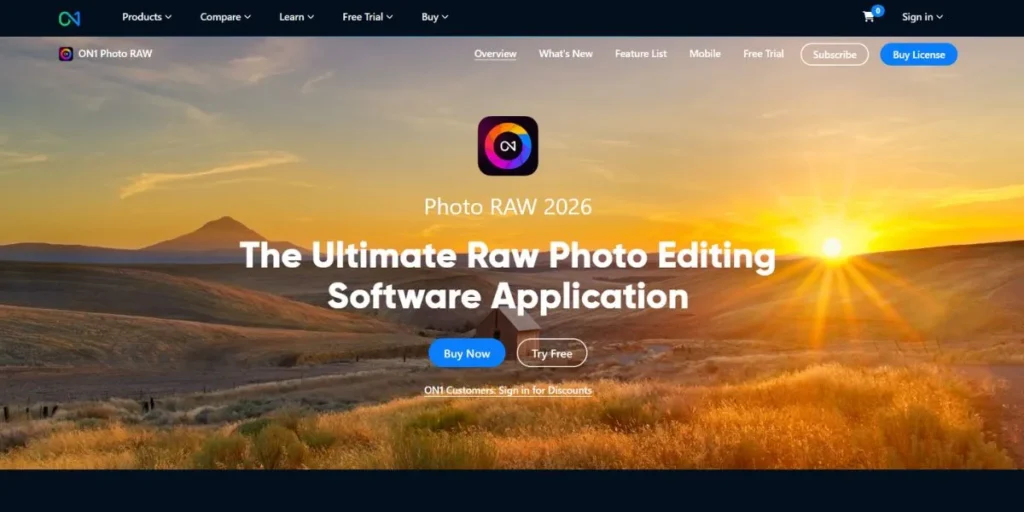
ON1 Photo RAW is a full-scale Lightroom alternative consisting of editing, effects and organization in a single cost-effective package. It makes everything non-destructive, and you can navigate through photos without any problem. It has a popular library of effects, which comprises textures, borders, and textures. New features and performance improvements are introduced every year.
Key Features:
- Browse module This is the place where you can get to in a hurry and quickly organize your photos.
- Effects: HDR, black and white, landscape
- Lots of effects: HDR, black and white, landscape
- AI masking to make things easy to pick.
- Option to put a tether and immediately go to the editor.
Pros:
- One time license is cheap and does not have subscriptions.
- All-in-one has no use of independent applications.
- It is updated on a regular basis.
Cons:
- Commercial: Slows with large libraries.
- Interface is cluttered in opposition to minimal designs.
- Some features lack polish found in specialized competitor applications
Website: https://www.on1.com/products/photo-raw
B) AI-Powered / Creative
5. Skylum Luminar Neo
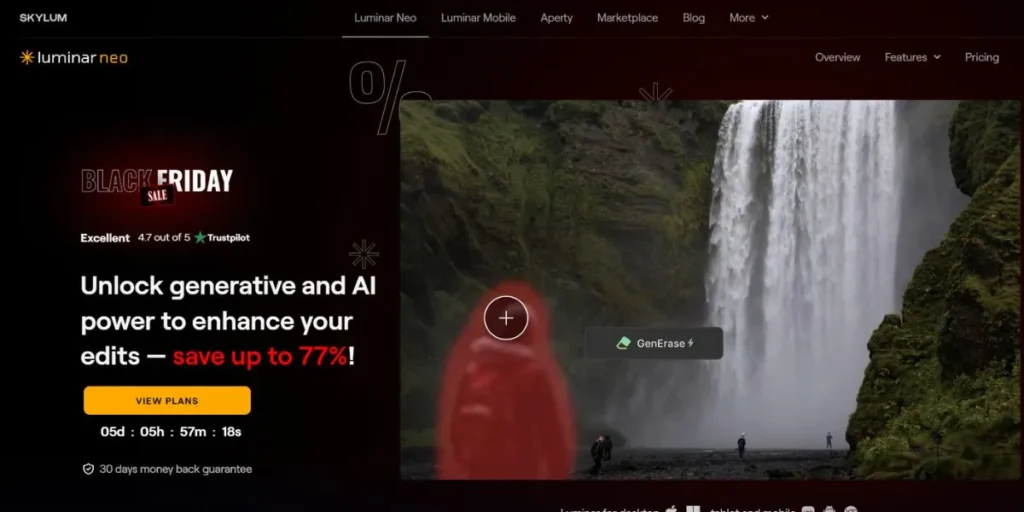
Skylum Luminar Neo is another newly released photo editor that emulates Lightroom by using AI. It automates hard adjustments, thus simplifying them. You are also able to change skies, enhance portraits, and add atmosphere with minimal manual effort. It allows you to edit files without the help of a catalog. It has specially designed features such as RelightAI, which enables you to adjust lighting after capturing a photograph, and SkinAI, which retouches facial skin in a natural way. It receives frequent updates, which introduce new AI functionality.
Key Features:
- SkyAI changes the skies in order to make it look like they exist and it automatically matches the lighting and reflections.
- FaceAI, SkinAI and BodyAI have a full retouch feature in portrait editing.
- RelightAI shifts the sources of light to alternative moods.
- Layer-based editing provides the ability to perform complex compositing when required.
- No catalog In a database without additional database maintenance, edit files directly.
Pros:
- AI devices reduce the amount of time spent on editing.
- The interface is user-friendly, therefore, new people can operate the sophisticated features.
- The creative tools are unique and handy as opposed to other editors.
Cons:
- It is difficult for those people who possess thousands of photos without the catalog.
- Periodically, AI requires some hand adjustments to work perfectly.
- Excessive AI workouts may slow down the computer.
Website: https://skylum.com/luminar
6. CyberLink PhotoDirector
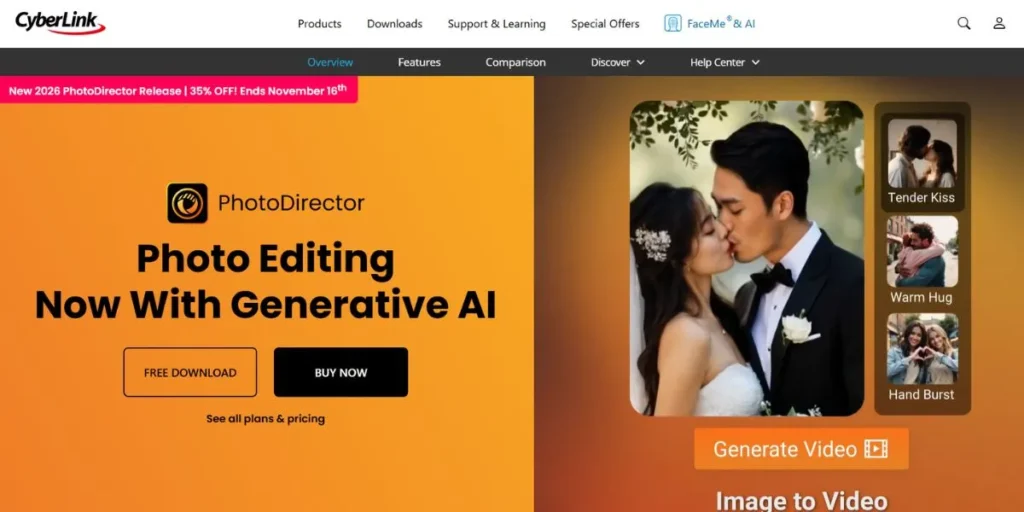
PhotoDirector by CyberLink is a full-fledged photo editor that is one of top Lightroom alternatives. It combines the conventional controls with the latest ones like motion blur eradication and the animated effects. Its guided modes will provide the beginner with step-by-step instructions on how to achieve professional looks.
It has features to cut elements of a photograph, do style drops, and arrange pictures, all at a moderate subscription. New releases introduce fun features such as the selection of objects in the background and the replacement of those objects with AI.
Key Features:
- AI sky replacement is light and reflection-friendly.
- Motion blur images smooth blurred motion pictures or dark images.
- Content-aware removal takes away undesired content and replaces it in a seamless manner.
- Style transfer is an automatic art transfer that copies processes.
- Video-to-photo software extracts good still photographs from videos.
Pros:
- Desktop and mobile applications at a single low price.
- There are too many tutorials allowing beginners to study quickly.
- New features are being added on a regular basis.
Cons:
- There are numerous panels and choices.
- The results of certain AI tools are not even, and manual corrections are required.
- It is not powerful like professional editors that are prepared by specialists.
Website: https://www.cyberlink.com/products/photodirector-photo-editing-software-365
7. Zoner Photo Studio X
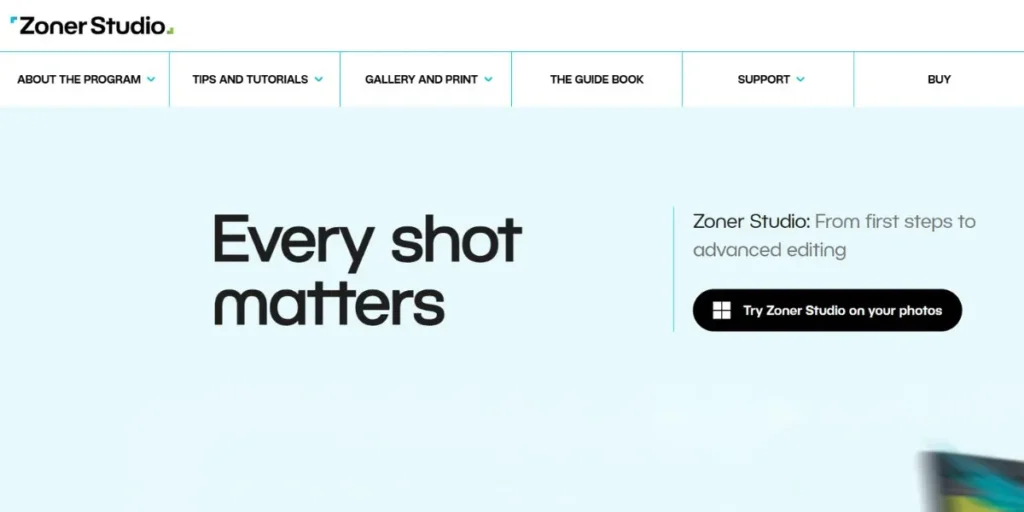
Zoner Photo Studio X is a full Lightroom alternative which guides you through the entire process of workflow, i.e. importing and sharing on social media. It is a photo organization system, RAW processing system, and publishing tool. The interface remains by itself, but it does not lack strong functionalities among serious photographers. It has GPS mapping of geotagged photos, facial recognition of grouping people and also batch processing of quick repetitive activities. In the calendar views and metadata filtering, you can search the necessary images easily.
Key Features:
- Complete workflow: upload, edit, organize and publish.
- Photo location GPS mapping on interactive world maps.
- People are automatically identified via collections using facial recognition.
- Batch processing is an efficient method of processing high numbers of photos.
- Direct publishing to social media and photo-sharing platforms.
Pros:
- The yearly subscription is highly profitable to all the features.
- The guide would guide you when both taking and finishing a picture.
- It can be updated frequently to support the latest cameras and formats.
Cons:
- It is not as well-established as the major industry brands.
- Certain sophisticated editing tools trail the niche competitors.
- There are fewer tutorials and help from the community.
Website: https://www.zoner.com
C) Free & Open-Source
8. RawTherapee
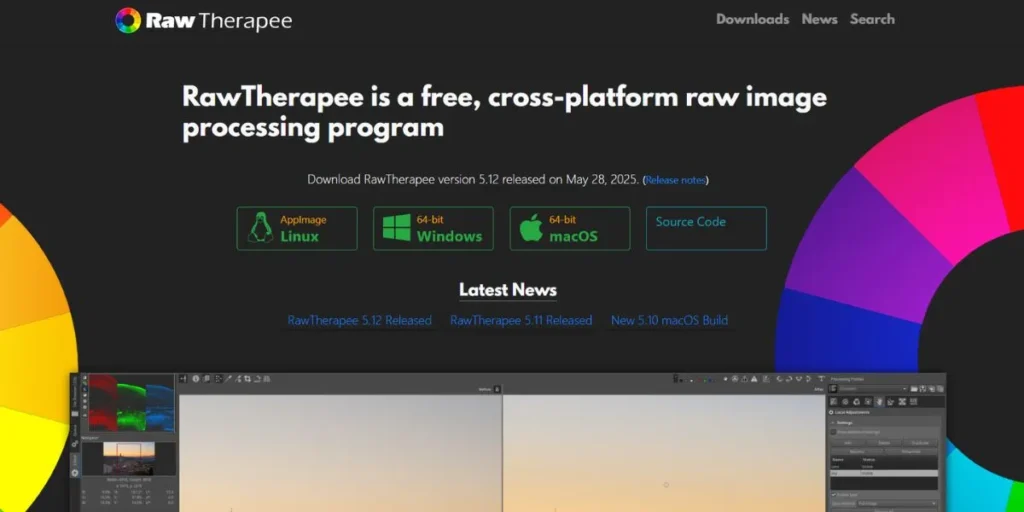
RawTherapee is a potent open-source editor that can provide free professional processing to the RAW files. It provides the ultimate control over all aspects of image development with detailed adjustment planes.
RawTherapee has highlights and shadows pullouts, has numerous demosaicing modes to allow optimum RAW extraction, and will do huge batches without quality loss. It is open-source, which implies that work is open,and community updates make it better, and that no vendor lock-in occurs.
Key Features:
- Poorest RAW conversions (poor demosaicing algorithm) exist.
- Fine-tuning tone-curve adjustments enable you to fine-tune tones.
- Various noise-cutting techniques are applicable to different types of shooting.
- Batch works on numerous images simultaneously in a relaxed manner.
- Freedom of choice, no limitations, no watermarks, and no hidden fees.
Pros:
- Professional functionalities are equivalent to the expensive business packages.
- Vibrant community guarantees up-to-date and regular repairs.
- No subscription or license cost is ever.
Cons:
- The learning curve may be high to users who prefer plain screens.
- The appearance is aged in the view of modern designs.
- Less integrated organization software requires another system.
Website: https://rawtherapee.com
9. Darktable
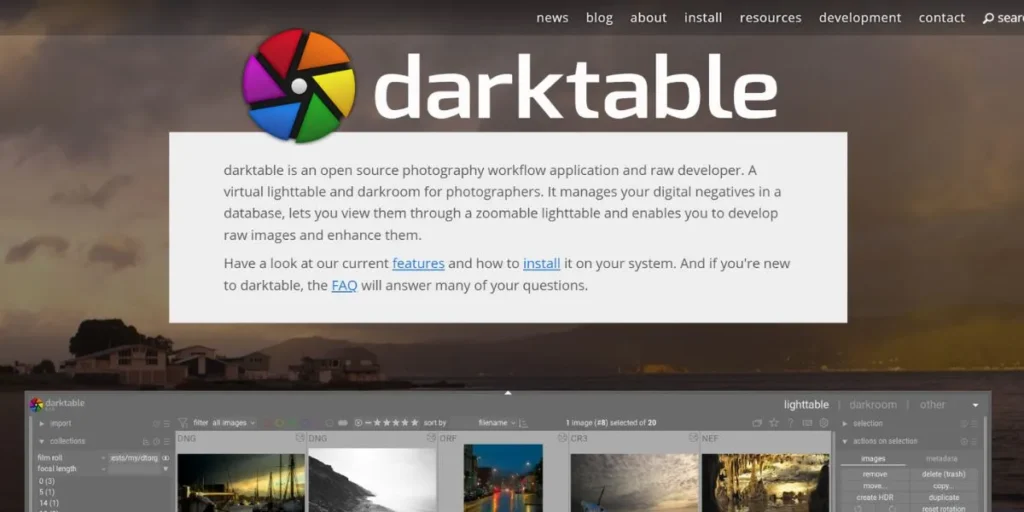
Darktable is a comprehensive free editor and provides non-destructive editing of RAWs and smart management of assets. It is often regarded as one of the best Lightroom Alternatives, dealing with the entire process of importation and exportation, maintaining professionalism.
The module system of Darktable provides extensive adjustment of colour, tone and detail. It pushes the tethered shooting, lens corrections, as well as numerous export choices. The project, being community-based, remains transparent, open, and under an unwavering improvement process by developers.
Key Features:
- There are the Lighttable and darkroom modules that separate organization and editing.
- RAW supports most camera formats.
- Masking tools allow you to fine-tune a part of the picture.
- Color control maintains proper reproduction across all devices.
- Geotagged photos are displayed in interactive map views in-store.
Pros:
- Free and is similar to a big part of the premium software.
- Non-destructive editing preserves originals giving it infinite flexibility.
- Windows-based, Mac-based, and Linux-based.
Cons:
- The interface can get complicated in the hands of those individuals seeking a simplistic interaction.
- Performance is reduced on less powerful hardware.
- The number of tutorials is lower because of community size.
Website: https://www.darktable.org
10. digiKam
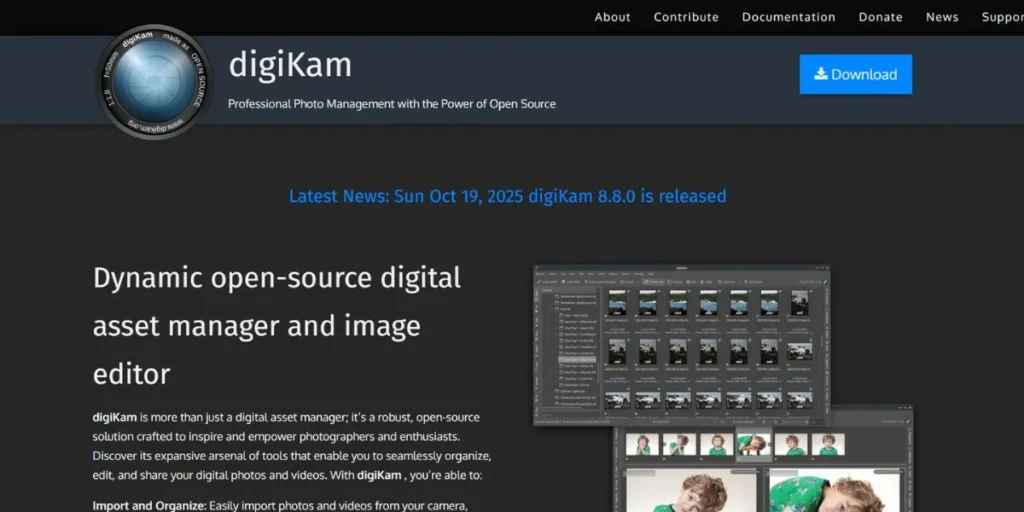
digiKam can be used primarily as an impressive photo organizer and it adds Lightroom-like editing capabilities. It is open‑source. It is most useful with big sets of pictures, as it can store much information about the pictures, add tags and allow searching with ease.
It is also applicable to the program in that it provides the ability to edit multiple photos simultaneously, whether it be renaming them, altering their file format, or transferring the same set of modifications to thousands of photos. The process of editing is simplistic; more serious retouching may require additional software. The reason behind this is that digiKam is free, which makes it a suitable alternative to photographers who are not that keen on ordering an extensive library system and still require one.
Key Features:
- Large database with ability to store hundreds of thousands of photos.
- It is possible to edit tagging and metadata in batch with ease to ease the organization.
- Face recognition and labeling locate faces in all your pictures of yours.
- Has a basic email editor to make simple economic changes.
- Supports Windows operating systems, and macOS as well as numerous Linux editions.
Pros:
- Free tools that are competing with dedicated managers that are costly.
- Millions of searches and filters to locate pictures quickly.
- New features are added to the project regularly.
Cons:
- The editing software used is poor in comparison with specialized photo editors.
- The creation and maintenance of the database requires a little technical expertise.
- The interface is confusing when you are in need of a minimalistic experience.
Website: https://www.digikam.org
11. LightZone
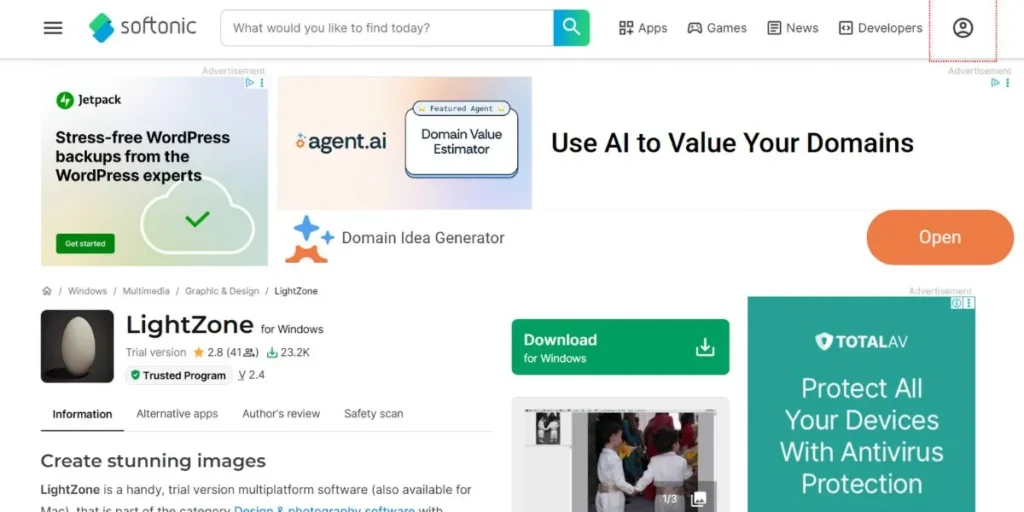
LightZone is another free application enabling you to edit images in a manner that the classic Zone System is working. It is open-source and edits non-destructively and has a stack of layers you are able to add or remove. As one of the noteworthy Lightroom Alternatives, it offers photographers a powerful yet simple workflow without the cost of commercial software.
Zonamapper of LightZone synthetic displays the exposure regions of Ansel Adams, hence you can adjust particular tonal regions. RAW files of most cameras can be opened and it is not complicated as most other editors. Free software also entails it being available to anyone to trial it freely.
Key Features:
- ZoneMapper provides the use of the Zone System of Ansel Adams in digital editing.
- floors Stack-based editing retains use of changes as non-destructive.
- RAW files of large cameras are welcomed with no additional licences.
- We have introduced a Relight tool which gives you a chance to move light in a picture and create dramatic effects.
- 100 % free, no hidden limits
Pros:
- An appreciative concept that draws the attention of photographers who are familiar with the Zone System.
- Simple interface in comparison to heavy-documented editors.
- Open source and not closed so that everybody can use it.
Cons:
- There was a period when its development halted, although the community keeps it up to date.
- It does not have as many advanced features as the available commercial tools.
- Low number of users implies less tutorials and assistance.
Website: https://lightzone.en.softonic.com
D) Online / Browser-Based
12. Photopea
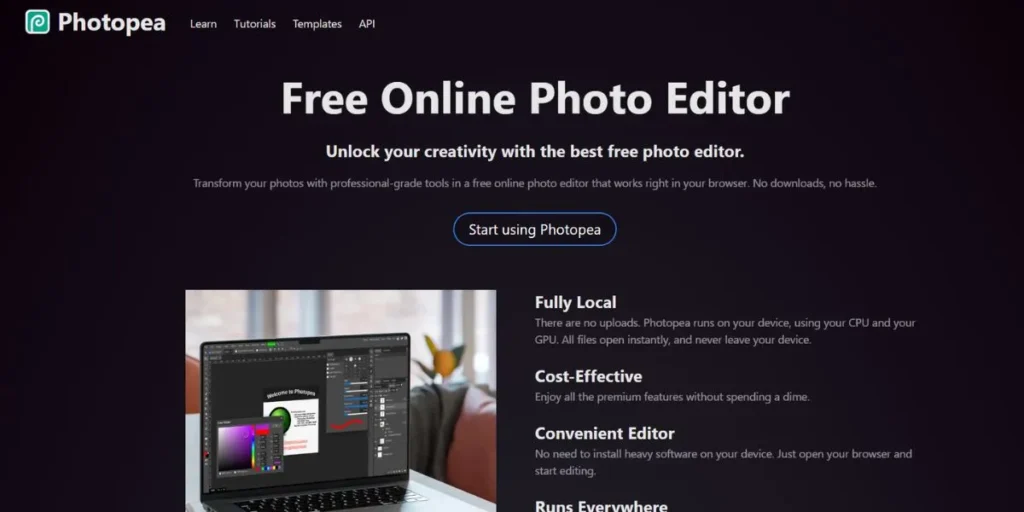
Lightroom Photophotope is a web-based editor that is Lightroom-like and requires no downloads or accounts to use. It operates within a current-day browser. Photopea is capable of opening a wide variety of file formats, including PSD, XCF, as well as standard image files.
It has the support of layers, adjustment layers and selection tools like desktop programs. Since it is a browser-based one can edit anywhere as long as he/she has access to the internet, thus making it easy to make amendments promptly in case a person is not at his/her main workstation.
Key Features:
- Browsing is possible with no downloading or installing of any app.
- Supports opening of PSD, XCF and Sketch files and regular images.
- Adjustment layers and blending modes of layers editing.
- selection tools such as magic wand, lasso and smart selections.
- Free of charge with a paid version that will remove advertisements.
Pros:
- The speed of access via any web browser device.
- It does not make it easy to install with the aid of casual users.
- Is easy to recognize among those who are already using desktop editors.
Cons:
- Requires connection to the internet at all times.
- Browser restrictions may reduce performance speed to that of native applications.
- Pictures posted on the Internet might be a cause of privacy concern.
Website: https://www.photopea.com
13. Pixlr
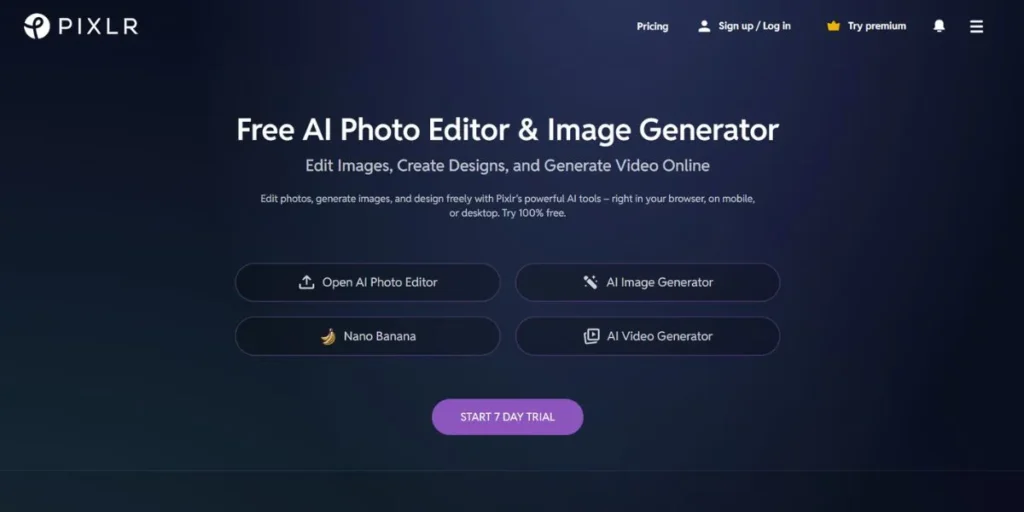
Pixlr is one of the best Lightroom alternatives, which is either easy or difficult depending on expertise. It has Pixlr E when power users are needed and Pixlr X when templates are needed. It supports common image-related files and also relies on AI tools as the background removal one and the object selection tool.
The template library provides the pre-coded layouts of social media, collages, and design projects. The simplistic version is free with a premium version available at a fee with additional functionality and removal of commercials.
Key Features:
- Two beginner and advanced user interfaces.
- Background remover AI automatically removes the background.
- mass template library of social media designs.
- Cloud storage will ensure that projects are available everywhere.
- Mobile applications provide the possibility to edit.
Pros:
- Web-based so that you do not have to install anything.
- The free tier is much more functional.
- Templates also ensure that social media content is easy to produce.
Cons:
- RAW file support is not as extensive as compared to desktop software.
- The free version contains advertisements that disrupt the working.
- Needs internet, and hence is not editable when offline.
Website: https://pixlr.com
E) Mobile (Android/iOS)
14. Snapseed
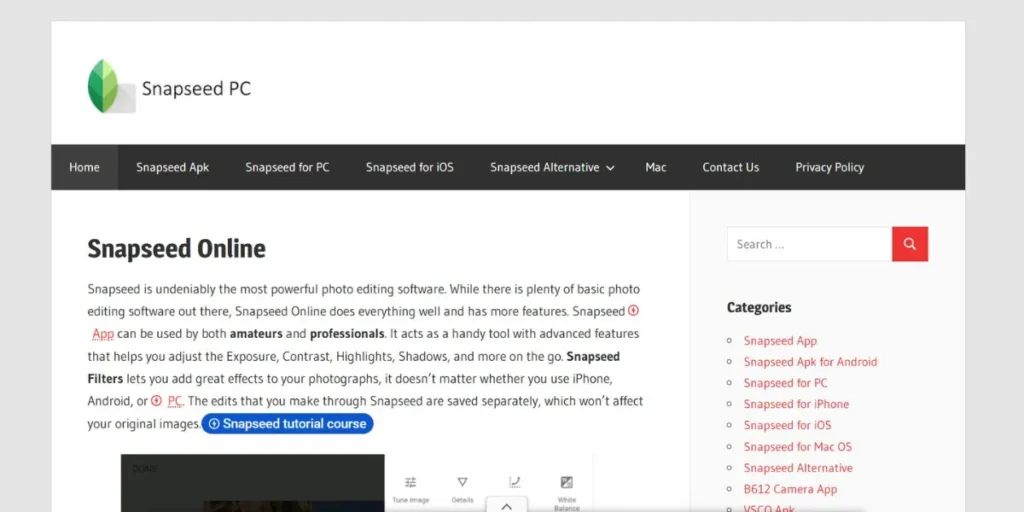
The most prominent mobile editor is Snapseed, and it is a smartphone-based Lightroom. It was constructed by Google and provides a complete in-store including enhancements of selective edits, healing brushes, and perspective fixing entirely without costs.
The application relies on gestures, which are swipes and pinches, to make it easy to edit on a phone. Segmentation Snapseed contains such distinctive filters as Vintage, Drama and HDR Scape filters which can transform a regular image into a remarkable one. All people can download it without any expenditure, and it does not have advertisements or in-app purchases.
Key Features:
- The selective tools create the opportunity to edit specific aspects of a photo without hard masks.
- Healing brush removes the unwanted spots/objects with clean results.
- The perspective tool normalizes the buildings or other distortions of images.
- Professional mobile edit support in RAW file.
- Absolutely free, no advertisements, purchases.
Pros:
- Quality applications that can compete with most desktop applications.
- Touch interface functionality is good in phones.
- On unlimited use, free access provides unlimited access.
Cons:
- You only have it in mobile form, no desktop capabilities.
- Not very good at managing files and hence you require an additional application.
- Detailed work can be made hard by these small screens.
Website: https://snapseedpc.online/
15. VSCO
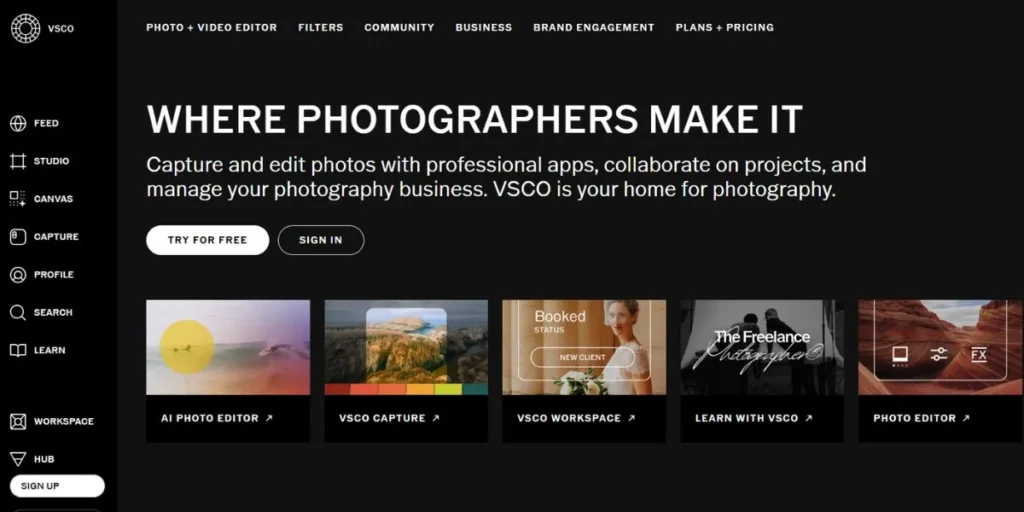
VSCO is a photo app that resembles Lightroom and is creativity-based. It also includes filters in the form of an old film and allows people to share pictures and get ideas. It works on phones. It has convenient exposure, colour, and grain adjusting tools. A free account provides only basic tools; a paid account is provided with all presets and additional functionality.
Key Features:
- Huge amounts of presets that recreate the looks of old film, modern appearance.
- Their tools allow controlling color, saturation, brightness, grain and split toning to a very fine level.
- You have an option of saving a collection of corrections in the form of a recipe.
- Functions to share photos and get inspired by others.
- It is also possible to edit videos and not only photos.
Pros:
- The movie previews are clear and simple to use.
- The interface is simple and clean therefore you can get down to creating.
- It inspires the community and makes you able to associate with people.
Cons:
- Paid plans are required to get all presets.
- Sharing is emphasized over both individual editing only.
- Organization tools do not have as much power as specialized photo managers.
Website: https://www.vsco.co
Conclusion
It may be that your project requires more or less money and more or less features and how you work, is it high job, low job or ambidextrous? The best technical results are fancy with the help of Capture One Pro or DxO PhotoLab that are frequently used by the professionals. Luminar Neo could be appealing to the creativity of people due to its AI tools.
Free or low-cost alternatives such as Darktable and RawTherapee offer good functionality that can be matched in expensive programs. Snapseed can offer powerful editing to mobile users at no expense. There are a lot of choices, and therefore every photographer will be able to find a software that suits his or her style, requirements, and budget.
FAQs
Can free Lightroom alternatives match professional software quality for serious photography work?
Yes. RAW processing and non-destructive editing plus numerous adjustment tools of high quality are provided in free programs like Darktable and Raw Therapee which are comparable to expensive software.
Which Lightroom alternative works best for photographers managing thousands of images efficiently?
digiKam is optimal in terms of dealing with huge libraries. It is organized in a database, is able to read every photo detail, and can also identify the faces to assist in sorting the thousands of photos in a short period of time.
Do Lightroom alternatives support RAW files from all major camera manufacturers reliably?
Majority of the substitutes such as Capture One, DxO PhotoLab, Darktable and RawTherapee are capable of getting RAW files of major camera brands. Nevertheless, before purchasing it is a good idea to verify compatibility.
Can I edit photos on mobile devices as effectively as desktop computers?
Snapseed provides you with the potent mobile editing features, such as selective manipulations, healing, and RAW. It allows you to make professional level edits using your phone.
